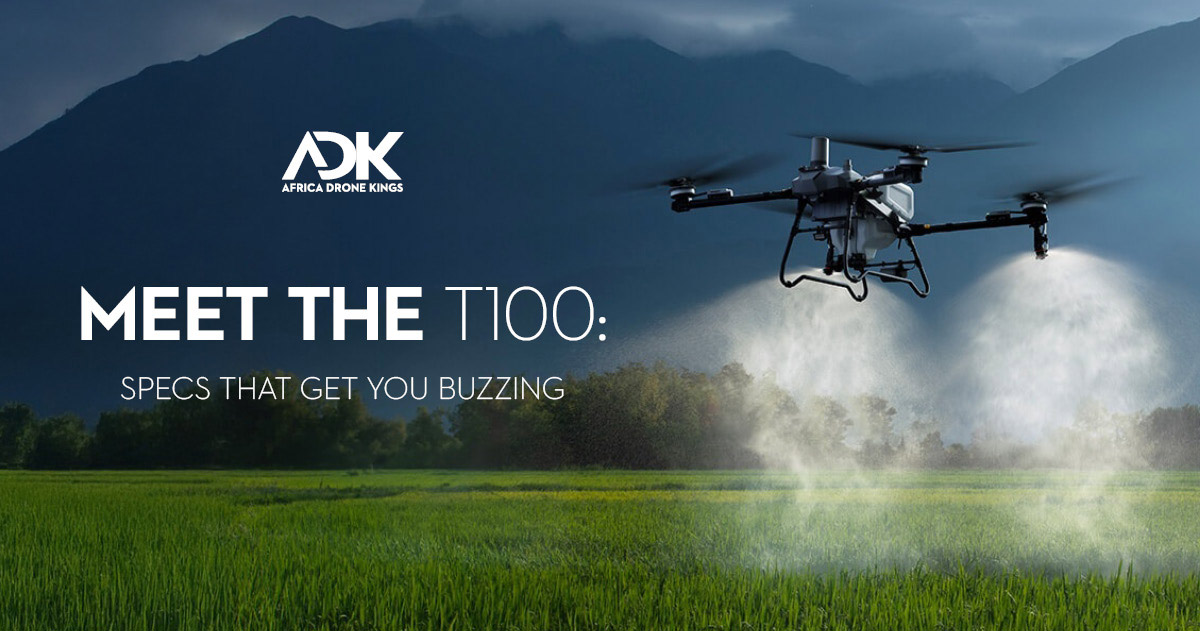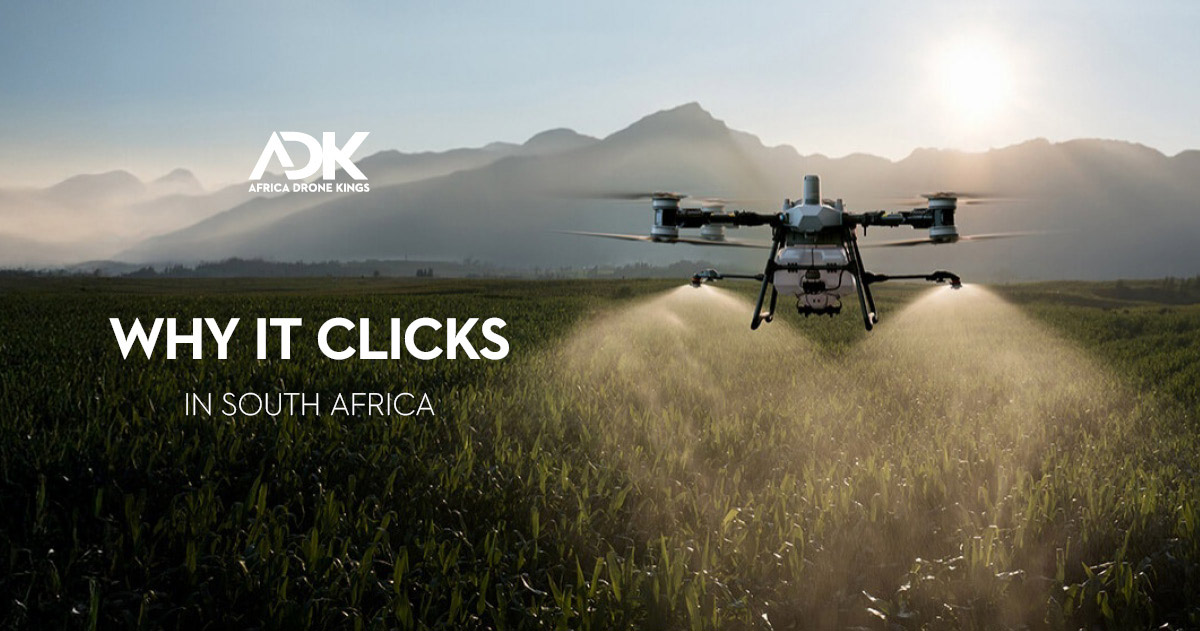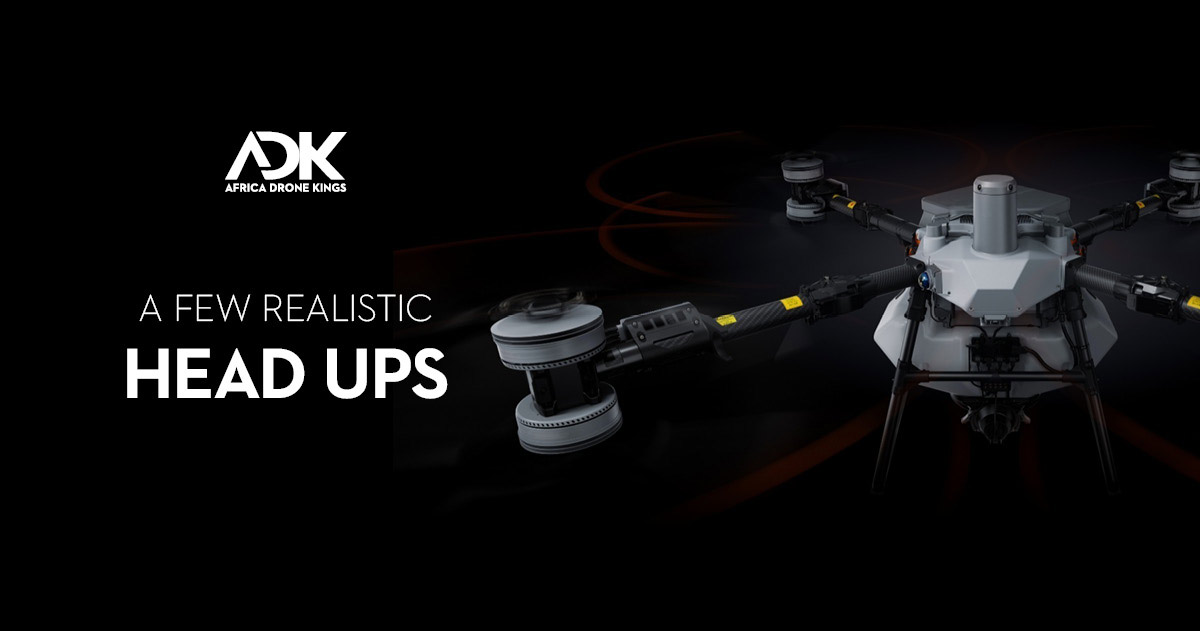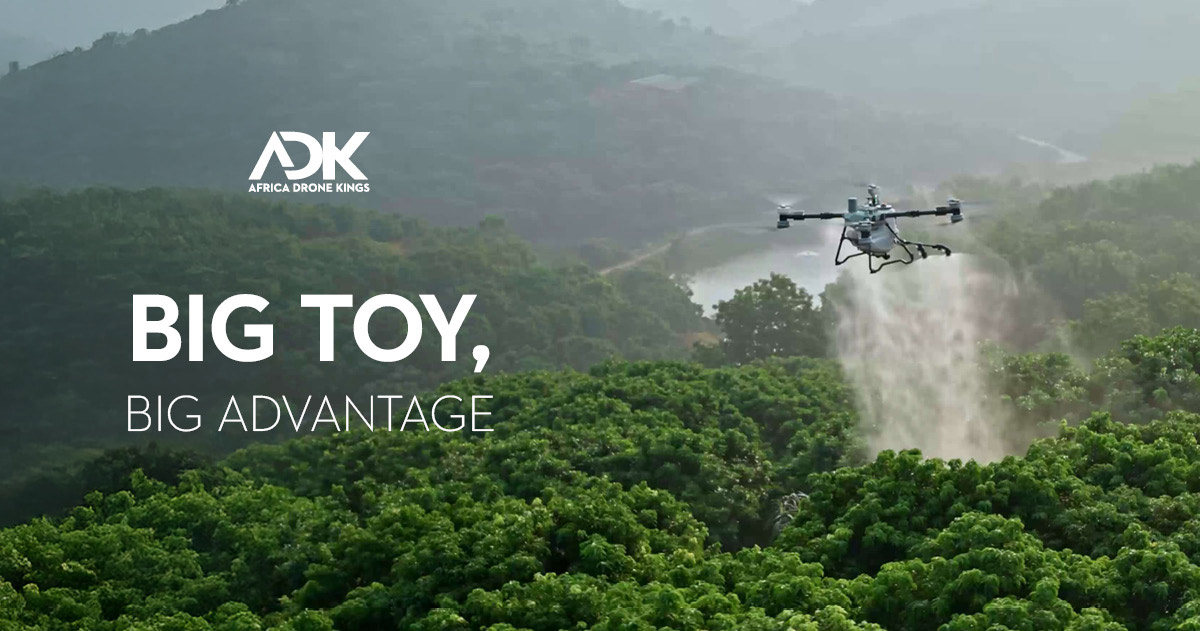The DJI Agras T100 has arrived in South Africa and it is already being called a game changer for large scale farming. This drone is not designed for hobbyists, it is built for real work on real farms. With record payload capacity, precision spraying, spreading and even lifting capabilities, the T100 gives South African farmers a serious tool to tackle challenges like labour shortages, chemical efficiency and time management.

Meet the T100: Specs That Get You Buzzing
The DJI Agras T100 is not shy about flexing its muscle. It is the heaviest hitter in DJI’s agricultural line up and the numbers tell the story. At its core is a 100 litre spray tank that sets a new standard for agricultural drones. Depending on nozzle configuration, it can deliver either 30 litres per minute with two nozzles or a full 40 litres per minute with four nozzles. That makes it nearly double the output of the Agras T50, which topped out at 16 to 22 litres per minute.
In real field terms this means the T100 can cover 12 hectares per hour under standard spraying operations. On a large maize farm in Mpumalanga, for example, a block of 1000 hectares can be completed in roughly half the time that older drones would take, saving both labour and chemical costs.
Power comes from newly designed high-capacity batteries. Each pack delivers enough juice for heavy payload missions and, importantly, they recharge extremely fast. A single battery can go from 30 percent to 95 percent in about nine minutes when paired with DJI’s smart charging system. This rapid turnaround reduces downtime and allows continuous spraying rotations when using two or three batteries in cycle.
The drone is not just a sprayer. For spreading jobs such as fertilizer granules or cover crop seed, it swaps in a 150 litre hopper capable of handling up to 400 kilograms per minute. That means large citrus orchards or sugarcane fields can be fertilised evenly without tractors dragging spreaders across the soil.
The versatility continues with lifting mode. Using a ten metre cable system, the Agras T100 can safely hoist 85 to 100 kilograms. That makes it handy for moving irrigation pipes, carrying water pumps into tough terrain, or transporting soil sampling equipment where access is limited.
The frame itself is built to handle this muscle. It uses reinforced arms, carbon fibre elements and a foldable design to fit onto a bakkie or trailer. The maximum take-off weight, depending on configuration, is over 100 kilograms, yet the foldable body means it is still practical for daily deployment.
All of this performance sits on top of DJI’s advanced flight control system, giving stability in wind, precise RTK positioning and fully automated flight routes for spraying or spreading. In other words, it is a serious workhorse designed to match the demands of modern commercial farming in South Africa.

Safety Smarts That Keep You Flying
A drone this powerful cannot just be about brute force, it needs brains too. DJI has packed the Agras T100 with some of the most advanced sensing and safety systems ever seen on an agricultural drone.
At the heart of its awareness is a millimetre wave radar system that constantly scans in all directions, detecting obstacles regardless of dust, light or weather. This is paired with a lidar module that measures distance with laser precision, ensuring the drone can maintain safe clearance above crops or uneven ground. Together they give the pilot a complete 360 degree safety net.
Adding to this is DJI’s new Penta Vision multisensor system. Using five wide-angle cameras, the T100 builds a real-time visual map of its surroundings out to 60 metres. This allows it to identify poles, wires, trees and even irregular terrain that would normally pose risks for big agricultural equipment. With both radar and vision working together, the drone is capable of detecting and avoiding hazards automatically, even in tricky environments.
One of the standout features for South African farmers is the terrain following ability. Many local farms, from the Western Cape winelands to the hills of KwaZulu-Natal, are anything but flat. The T100 can hug slopes and maintain consistent spraying height thanks to its lidar and radar fusion. This ensures chemicals are applied evenly whether on flat maize fields or steep vineyards.
Navigation accuracy is equally impressive. With RTK (Real-Time Kinematic) positioning, the T100 achieves up to 10 centimetres accuracy horizontally and vertically. That level of precision allows repeatable flight paths over orchards and eliminates overlaps or gaps in spraying. When you are applying expensive pesticides or liquid fertilizer, that accuracy translates directly into savings.
DJI has also included redundant safety layers. Dual barometers, dual compasses and backup communication systems reduce the chance of failure during long missions. If something does go wrong, the drone can initiate an automatic return-to-home using its smart obstacle avoidance system, giving farmers peace of mind when operating over valuable crops.
Night or low light spraying is also safer with the T100. The radar and lidar do not rely on visible light, so they work just as well at dawn or dusk, times when many farmers prefer to spray due to calmer winds and lower evaporation rates.
These safety systems are not just bells and whistles, they are what make the difference between an expensive liability and a dependable farm tool. For South African conditions, with our mix of weather, uneven landscapes and infrastructure, the T100’s smart sensing suite is exactly what farmers need to keep operations both safe and productive.

Why It Clicks in South Africa
Farming in South Africa is anything but simple. Our landscapes shift from flat, endless maize belts in Mpumalanga to rugged vineyards tucked into the slopes of Stellenbosch and the citrus orchards of Limpopo that stretch as far as the eye can see. The DJI Agras T100 is built with exactly this kind of diversity in mind.
For citrus growers in Limpopo and the Eastern Cape, the biggest battle is against pests and fungal diseases that spread quickly if not contained. Traditionally, boom sprayers waste chemicals by over-application and drift, especially in windy valley conditions. The T100’s precision spraying applies just the right dose, tree by tree, and its atomised mist reduces drift, which means healthier crops and lower input costs.
Move down to the Cape winelands, and the challenge is steep terrain. Many vineyards are planted on slopes where tractors cannot safely operate. The T100’s terrain-following system uses lidar to hug the contour of the slope, keeping a steady spraying height even when the ground drops or rises sharply. This consistency makes it easier for vineyard managers to maintain grape quality while cutting back on manual labour.
In Mpumalanga and the Free State, maize and sunflower growers face massive fields where time is money. Covering 12 hectares an hour, the T100 turns what could take days into a matter of hours. Farmers can schedule spraying in the early morning or evening when winds are calmer and evaporation is lower, confident that the drone’s radar and vision systems will keep it flying safely.
For sugarcane farmers in KwaZulu-Natal, the crop’s tall and dense nature makes uniform application tricky. The T100’s strong downdraft and atomisation technology push the spray down deep into the canopy where it is needed most. That not only improves pest control but also reduces chemical runoff into waterways, a key concern in environmentally sensitive regions.
And then there’s the lifting mode, which many farmers overlook at first. On mixed farms, it can be used to haul irrigation pipes, small water pumps, or even fencing material into areas where tractors and bakkies cannot reach. For research farms, carrying soil sensors or weather equipment into remote plots saves hours of manual labour.
The bigger picture here is that the T100 does more than just spray or spread. It helps South African farmers manage time more effectively, reduce wastage of expensive chemicals, cut fuel costs by replacing tractor runs, and operate more sustainably. In a sector where margins are tight and weather is unpredictable, that kind of versatility is pure gold.

A Few Realistic Head Ups
The T100 is not a lightweight. Fully loaded it weighs 77 kilograms, so safe handling requires a two person crew and proper transport. A bakkie or trailer is usually needed, and ramps make loading safer.
Fog or heavy mist can confuse the sensors, so flying in those conditions is not recommended. Spray plans should take local weather into account.
Another important point is regulation. Any agricultural spraying drone in South Africa must be registered with the South African Civil Aviation Authority under Part 101, and operators must be trained and licensed. Local partners like Afri Air and other DJI enterprise dealers provide training, service and support to help farmers comply.

Big Toy, Big Advantage
The DJI Agras T100 is more than an upgrade, it is a leap in drone farming technology. It combines heavy payloads with fast charging, advanced safety systems and pinpoint accuracy. While it requires investment and compliance, the return in saved labour, reduced chemical use and higher efficiency makes it a powerful tool for South African agriculture.
The good news is that local suppliers such as Africa Drone Kings are making the T100 easier to access. With Payflex buy now, pay later plans at 0% interest, farmers can spread out payments while still getting the productivity boost immediately. Add in a 12 month warranty and 7 day hassle free returns, and it becomes a secure investment backed by local support.
Whether you are running citrus orchards in Limpopo, vineyards in the Cape or maize fields in Mpumalanga, the T100 is designed to make farming smarter and more productive. With the right training and SACAA compliance, it has the potential to transform large scale farming in South Africa.

